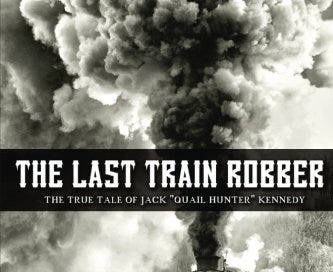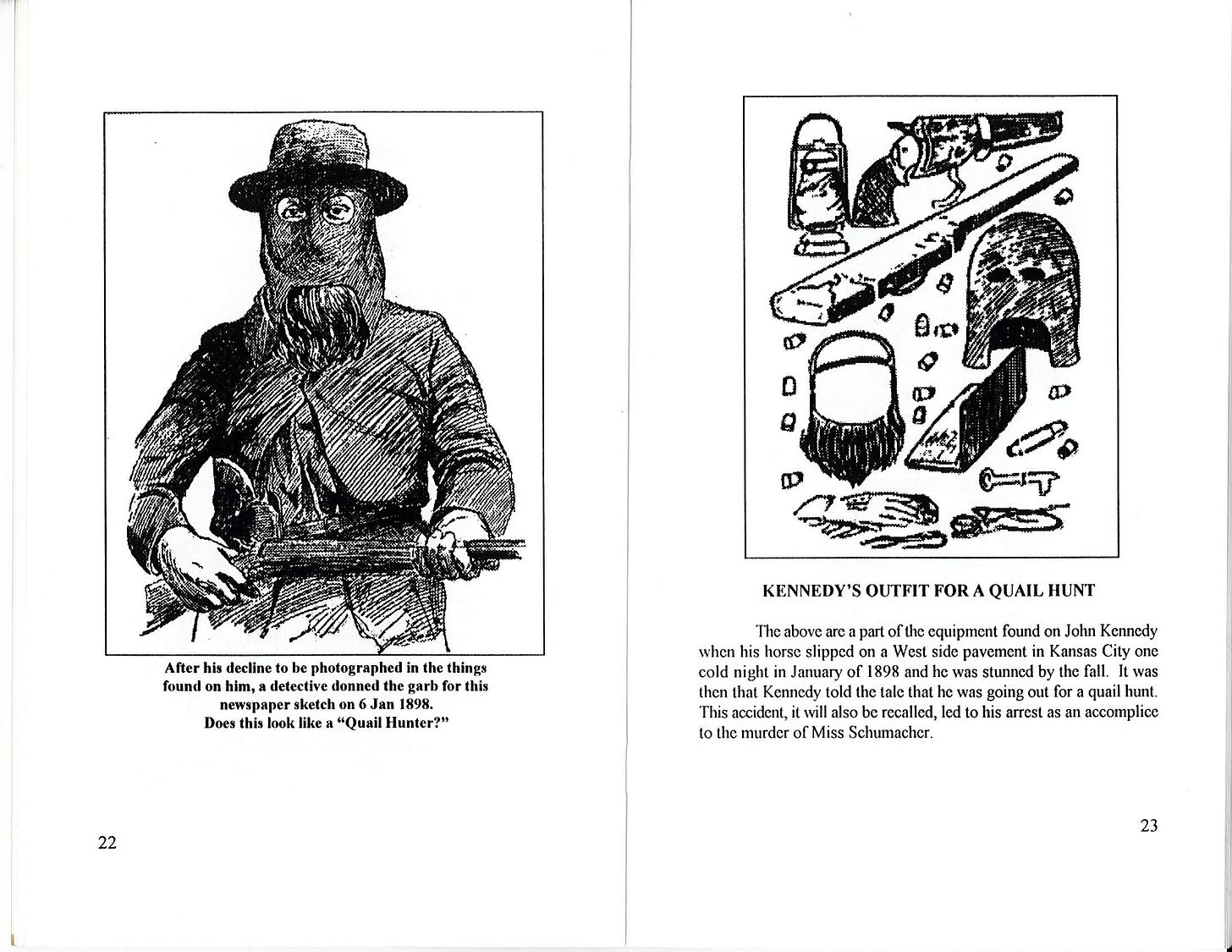Publishing the Quail Hunter's Story
Detailing the few times Jack Kennedy's story has be published
Hey there folks and happy post-victory Monday to all fellow Chiefs fans!
This week’s post is still more “laying the groundwork” for future articles. I want to talk about the various sources I’m using in my research of Jack Kennedy, where I found them, how you can find them, and even some sources I’ve not yet actually found. This also serves as a kind of introduction to my Bibliography page which is now active over at:
https://quailhunter.substack.com/p/bibliography
The Books:
As with any research topic, finding sources related to the story of Jack Kennedy is the most involved process of the whole adventure. Two books kicked off my deep dive into the tale of the Quail Hunter, The Last Train Robber by Charles Rauh (2016) and Jack “Quail Hunter” Kennedy by Chuck Rabbas (1996). Today we’re going to talk a bit about these two texts and how even their inaccuracies have helped to flesh out Jack’s timeline.
Rauh’s book is readily available via Amazon and I highly recommend it as, regardless of it’s many shortcomings, the most definitive text when it comes to Jack Kennedy. Rabbas’ book is significantly smaller(18 pages of text), harder to find, and much of the relevant information is featured verbatim by Rauh. Both of these books do a good job of collecting the key moments in Jack’s story and are great starting points. If you simply want to know the basics of Jack’s most notable heists (Blue Cut, Leeds, Macomb, and Seventy-Six) these books have you covered. However, both texts suffer from the misinterpretation of original sources, use of unreliable secondary and tertiary sources to support claims, and a lack of useful citations.
These are understandable errors when so little has been published about Jack outside of newspaper articles from over a century ago. It just makes it all the more exciting to try and separate fact from myth!
Many upcoming articles in this newsletter will be dedicated to correcting some of the more noteworthy mistakes in these two books, though it is never my intention to denigrate the work of the authors. The collection of images, sketches, and quotes in both texts has proven a priceless baseline for this project. I do plan to do proper reviews of both books in the future as well.
While these are the only two books solely dedicated to the Quail Hunter himself, a handful of others are incredibly useful for added historical context. Some of them include:
Son of a Bandit by Ralph A. Monaco II: Detailing the life of Jesse James Jr. and his involvement with the “Leeds Gang” and Jack Kennedy as well as Junior’s life post-criminal career.
Jesse James and the First Missouri Train Robbery by Ronald Beights: an early biography of Jesse James first published in 1874.
Jesse James, My Father by Jesse James Jr.: The story of Jesse James told by his own son. I highly recommend the audiobook of this text.
Historical Atlas of the Outlaw West by Richard Patterson: Features a number of stories and short biographies ranging from the James and Younger gang to the Wild Bunch and many more.
Newspapers:
Here comes the most extensive group of sources for this whole project. I believe my full list is currently near or just over 300 different articles from dozens of different newspapers around the country.
Newspapers most notably covered Jack’s story at two specific instances: during the Macomb Trial and investigation of Emma Schumacher’s murder in the fall of 1899 and after his death in November of 1922.
The Kansas City Star had at least one article mentioning Jack nearly every day in October and November of 1899. The coverage of Jack’s arrest and trial for Macomb spawned some of the longest articles as reporters relitigated Jack’s previous acquittals. This trial coverage was made all the more newsworthy as Jack Kennedy and John Redmond were the prime suspects in the murder of grocery store owner Emma Schumacher earlier that year. While Jack had been arrested for both the murder and the train robbery, Redmond fled to enlist in Roosevelt’s Rough Riders and ended up spending years in the Philippines.
After Jack and his young accomplice Lawrence Logsden (alias Harvey Logan) died at the hands of law enforcement in 1922 outside of Wittenberg, Missouri, the Associated Press sent a press release across the country. This article appears in well over a dozen different papers across the United States in the days following the botched robbery. It is from the coverage of his death that many of the misinterpretations and mistakes in his story are born. Be it from spectators telling reporters tall-tales of Jack starring in the film Beating Back (it was actually reformed train robber/ex-attorney Al Jennings of Oklahoma) or from writers butchering the spelling of Harvey Logan which spawned rumors of 3rd and 4th accomplices.
Other noteworthy information uncovered only in newspapers is the fact that Jack filmed a short film reenacting a train robbery which he showed at theaters like the Gillis Opera House in Kansas City. Advertisements for Jack’s film and accompanying lecture appear in a handful of papers from Kansas City to Wisconsin. The claims of Jack spending time fighting alongside Poncho Villa in Mexico also appear in newspapers, though the claim is still dubious so far as I’ve dug into it.
All of my cited newspapers are included in my Bibliography page via links to a Google Drive that has both the scans of many articles and the list of citations that link to online sources for the article.
Magazines and Other Documents:
This is where everything else pertaining to Jack has been found.
Articles in magazines like The Railway Man’s Magazine from February 1911 give not only a great summary of Jack’s criminal career but a peak into his career as a fireman, brakeman, and engineer for the railroads he would later rob.
Collections like that of William Orr, a prosecuting attorney in the Macomb trial, have proven to be amazing snapshots into the legal battle itself. Orr curated a small scrapbook filled with photographs and notes explaining the various characters, witnesses, and officials tied to the case. In the Bibliography page I have scanned and uploaded all of these items for readers to view themselves. A copy of the 1900 Trial Booklet for State of Missouri VS Jack Kennedy is also included and gives a detailed account of the witness testimonies and all other aspects of the trial. This is one of my favorite finds so far! While it did not necessarily provide new information, it fleshed out and detailed one of the biggest moments in Jack’s life.
I am constantly combing through library databases, the Internet Archive, and Ancestry.com to try and find new sources related to Jack. If you know of a book or article that I may not have found yet please let me know!
What Next:
Currently I am pursuing a few different leads to try and flesh out more of Jack’s story.
KCPD Historical Society - According to multiple articles from 1900 to 1922 the Kansas City Police displayed the mask, fake beard, and shotgun that were confiscated from Jack the night he earned his title “The Quail Hunter”. I’m reaching out to the KCPDHS in hopes of finding any archived police reports, arrest records, or any chance of these artifacts having survived all these years.
Gillis Theater - Jack’s short film is without a doubt lost to the ages but I am hopeful that I can find a brochure or other documentation mentioning it. I’m reaching out to multiple libraries, museums, and historical societies in Kansas City to try and find any mention of his film and lecture.
As always thank you so much for reading and I can’t wait to dive deeper into specific aspects of Jack’s story and utilize some of these sources! If you haven’t already please remember to subscribe so you get all the latest newsletters and updates as soon as the go out. I have also made it possible to pay for a monthly, annual, or “founding” subscription to the newsletter! These payments will unlock some upcoming “behind the scenes” blogs detailing how I go about tracking down sources plus some other fun stories along the way. Any money produced by this newsletter goes directly towards buying books, getting scans from libraries, and traveling to institutions and historic sites for in-person research.






